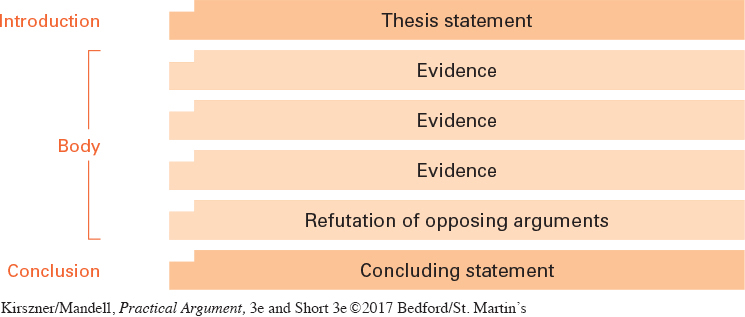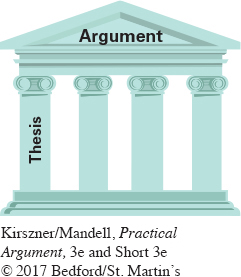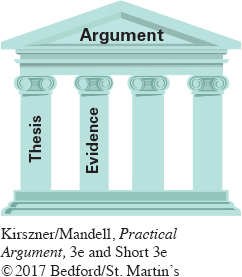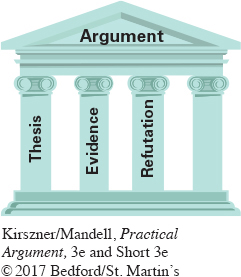The Elements of Argument
An argumentative essay includes the same three sections—
The following diagram illustrates one way to organize an argumentative essay.

The elements of an argumentative essay are like the pillars of an ancient Greek temple. Together, the four elements—

Page 25
Thesis Statement

A thesis statement is a single sentence that states your position on an issue. An argumentative essay must have an argumentative thesis—one that takes a firm stand. For example, on the issue of whether colleges should require all students to study a language other than English, your thesis statement could be any of the following (and other positions are also possible):
Colleges should require all students to study a foreign language.
Colleges should require all liberal arts majors to study a foreign language.
Colleges should require all students to take Spanish, Chinese, or Farsi.
Colleges should not require any students to study a foreign language.
An argumentative thesis must be debatable—that is, it must have at least two sides, stating a position with which some reasonable people might disagree. To confirm that your thesis is debatable, you should see if you can formulate an antithesis, or opposing argument. For example, the statement, “Our school has a foreign-
| THESIS | Our school should institute a foreign- |
| ANTITHESIS | Our school should not institute a foreign- |
(For more on thesis statements, see Chapter 7.)
Evidence

Evidence is the material—
Page 26
You will use both facts and opinions to support the points you make in your arguments. A fact is a statement that can be verified (proven to be true). An opinion is always open to debate because it is simply a personal judgment. Of course, the more knowledgeable the writer is, the more credible his or her opinion is. Thus, the opinion of a respected expert on language study will carry more weight than the opinion of a student with no particular expertise on the issue. However, if the student’s opinion is supported by facts, it will be much more convincing than an unsupported opinion.
FACTS
Some community colleges have no foreign-
language requirements. Some selective liberal arts colleges require all students to take two years or more of foreign-
language study. At some universities, undergraduates must take as many as fourteen foreign-
language credits. Some schools grant credit for high school language classes, allowing these courses to fulfill the college foreign-
language requirement.
UNSUPPORTED OPINIONS
Foreign-
language courses are not as important as math and science courses. Foreign-
language study should be a top priority on university campuses. Engineering majors should not have to take a foreign-
language course. It is not fair to force all students to study a foreign language.
SUPPORTED OPINIONS
The university requires all students to take a full year of foreign-
language study, but it is not doing enough to support those who need help. For example, it does not provide enough student tutors, and the language labs have no evening hours. According to Ruth Fuentes, chair of the Spanish department, nursing and criminal justice majors who take at least two years of Spanish have an easier time finding employment after graduation than students in those majors who do not study Spanish.
Refutation

Because every argument has more than one side, you should not assume that your readers will agree with you. On the contrary, readers usually need to be convinced that your position on an issue has merit. This means that you need to do more than just provide sufficient evidence in support of your position; you also need to refute (disprove or call into question) arguments that challenge your position, possibly acknowledging the strengths of those opposing arguments and then pointing out their shortcomings. For example, if you take a position in favor of requiring foreign-
Page 27
Concluding Statement

After you have provided convincing support for your position and refuted opposing arguments, you should end your essay with a strong concluding statement that reinforces your position. (The position that you want readers to remember is the one stated in your thesis, not the opposing arguments that you have refuted.) For example, you might conclude an essay in support of a foreign-
CHECKLIST
Does Your Argument Stand Up?
When you write an argumentative essay, check to make sure it includes all four of the elements you need to build a strong argument.
Do you have an argumentative thesis?
Do you include solid, convincing evidence to support your thesis?
Do you include a refutation of the most compelling arguments against your position?
Do you include a strong concluding statement?
The following student essay includes all four of the elements that are needed to build a convincing argument.